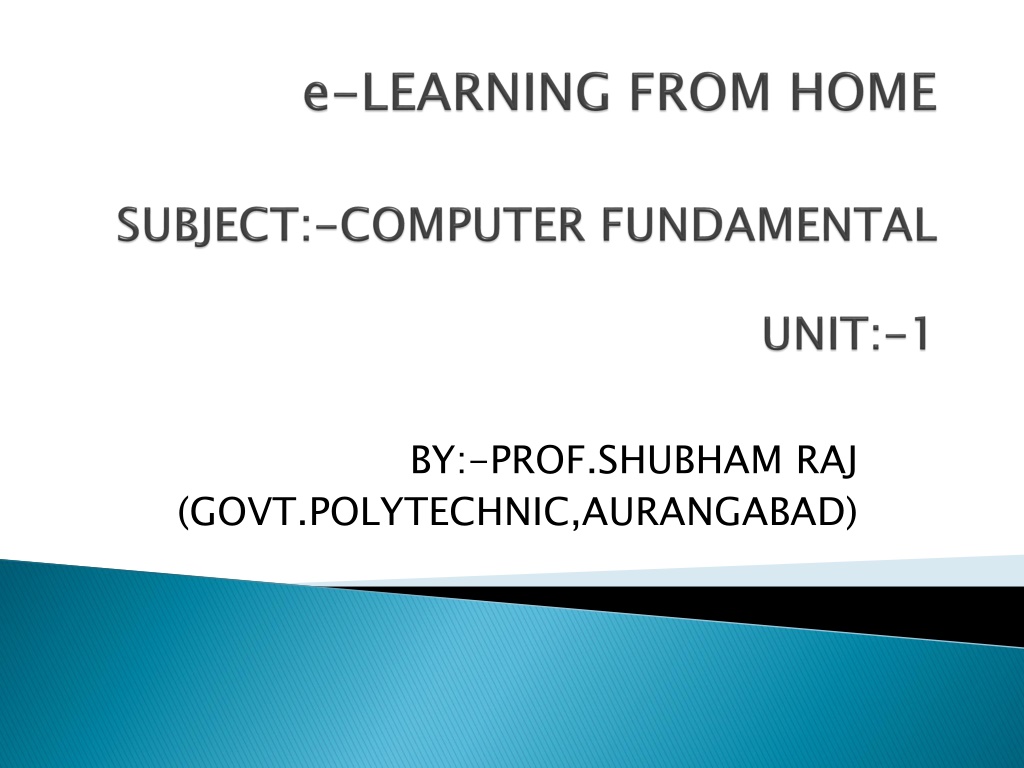Understanding the Basics of Computer and Its Components
A computer is an electronic device that processes data input by the user to provide output results. It comprises components like ALU, CU, and MU, each with specific functions. The CPU acts as the brain of the computer, transforming raw data into information. The system's memory units, RAM and ROM, store data, while input and output devices facilitate user interaction. Computers exhibit characteristics such as speed, accuracy, versatility, and storage capacity. The evolution of computer systems dates back to the Abacus, showcasing remarkable advancements in technology.
Download Presentation

Please find below an Image/Link to download the presentation.
The content on the website is provided AS IS for your information and personal use only. It may not be sold, licensed, or shared on other websites without obtaining consent from the author. Download presentation by click this link. If you encounter any issues during the download, it is possible that the publisher has removed the file from their server.
E N D
Presentation Transcript
BY:-PROF.SHUBHAM RAJ (GOVT.POLYTECHNIC,AURANGABAD)
Definition:- A computer is an electronic device which receives the data from the user as input, process it & give the results as an output. User can store the result or send from one place to another between more than one user. Block Diagram:- ALU CU ALU CU Input Input Output Output MU MU Input Deceives:- mouse, keyboard, joystick, barcode reader etc. Output Devices:- monitor, projector, speaker, headphone etc.
It is known as the brain of the computer which Is used for process the input data provided by the user to the computer system. Before process the input is known as the raw data, but after process it is known as information. The CPU consist of three component i-e a. ALU(Arithmetic Logic Unit) b. CU(Control Unit) c. MU(Memory Unit) ALU(Arithmetic Logic Unit):- It is responsible for Arithmetic and logical operations. Ex. Add, Sub , Mul , Div(Arithmetic) Compare, Bitwise Operator, And, Or etc.(Logical)
CU (Control Unit):- It is responsible for controlling all the activities whatever is running in to the system. It controls every thing by generating the control signals. MU(Memory Unit):- It is responsible for storing the data whether it is inside or outside of the system. It has following two types i-e Primary memory, Secondary Memory Memory Memory Primary memory Primary memory Secondary Memory Secondary Memory RAM, RAM, ROM ROM DISK, DISK, PENDRIVE, HARD DISK PENDRIVE, HARD DISK
RAM(Random RAM(Random Access Memory Access Memory) ) Static RAM Static RAM Dynamic Dynamic RAM RAM ROM(Read Only Memory) ROM(Read Only Memory) P ROM P ROM EP ROM EP ROM EEP ROM EEP ROM
The computer has many characteristics which is mention below a. Speed b. Accuracy c. Versatility d. Power of Remembering e. No feeling f. No IQ g. Storage
The first computer system was Abacus(counting device) Napier Bones(multiplication) Pascaline(1stadding device) Analytical Engine(1stGeneral purpose computer) Tabulating Machine(1stElectro mechanical machine) ENIAC(1stdigital computer) EDSAC(1stcomputer with storage) UNIVAC(General Purpose Electricity)
1stGeneration(1940-56)- Made of Vacuum Tubes Ex- Mark1,ENIAC 2ndGeneration(1956-63)- Made of Transistors Ex- IBM 1401 3rdGeneration(1963-71)- Made of IC Ex- FORTRAN,COBOL 4thGeneration(1971-present)- Made of VLSI Ex- Machine tosh 5thGenerations- Parallel processing(Made of SLSI) EX- AI, Robotics
The Computer are classified on three basis which is mention below. Classification of computer Classification of computer On the basis of size On the basis of size On the work On the basis of work basis of On the basis of purpose On the basis of purpose Mini computer Micro computer Main Frame computer Super computer Mini computer Analog Computer Analog Computer General purpose Special purpose General purpose Digital computer Hybrid Computer
There are multiple operations performed by the computer/processors. a. Instruction fetch b. Instruction Decode c. Instruction Execute d. Instruction Store e. Read and Write operation
There are five classic components are discussed below a. Data path:- through which data is coming to the system. b. Control:- generate control signals to maintain the system under control. c. Memory:- use to store the data. d. Input:- External devices to provide instruction to the system. e. Output:- Devices use to store the results.
It is all about to study of the CPU and its Front Part and Back Part. Go through page number 37,40,41 in your book(M.P Singh) and see the diagram and copy it in your note book. Assignment Questions: Q1. What is Computer System? Q2. Explain the System Unit with the diagram. Q3. Write five Input Devices and explain its working principal? Q4. Explain computer Operations? Q5. Explain characteristics of computer? Q6. Explain Processor with its Block Diagram? Q7. Solve the objectives of previous year?

 undefined
undefined























